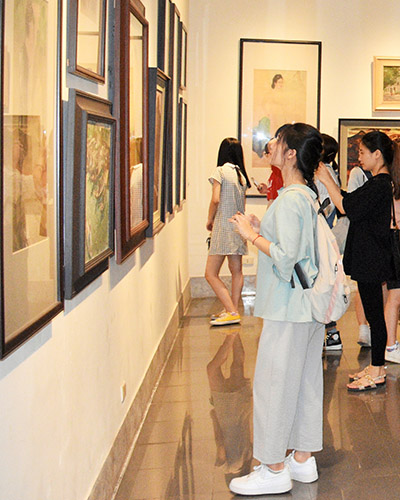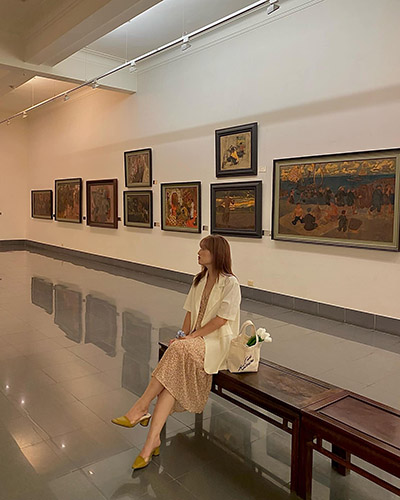Ha Noi Museum
Hanoi Museum was established in 1982 under the Decision of the People's Committee of Hanoi. Implementing
Resolution No. 15/2008/QH12, dated May 29, 2008 of the 12th National Assembly on adjustment of
administrative boundaries of Hanoi city and some neighboring provinces, Hanoi Museum and Ha Tay Museum was
enter to Hanoi Museum. From 1982 to May 10, 2010 Hanoi Museum has its head office at 5D, Ham Long, Hoan
Kiem, Hanoi.
.jpg)
.jpg)
Hanoi Museum currently holds more than 70,000 documents and artifacts (data until June 2021) of many
different materials, proving the history of thousands of years of Thang Long - Hanoi. A number of very
valuable artifacts and collections are appreciated by the limited school: co-valued collections; collection
includes porcelain; material collection ivory jade; collection of artifacts of the resistance revolution…
Hanoi Museum has 4 artifacts/groups that are very valuable national items, including: The gray-blue glazed
ceramic lampstand of the Mac dynasty of artisan Dang Huyen Thong; Bat Trang Long Communal House of Le
Dynasty; Thanh Mai bronze bell; Co Loa bronze and copper plow set in Co Loa bronze drum.
For many years, the Hanoi Museum has focused on collecting and building regular display content. The regular
display of the Museum has 7 themes and 33 sub-themes including: Theme 1: Nature; Theme 2: Journey to Thang
Long; Theme 3: Thang Long; Theme 4: Hanoi in the XIX - XX centuries; Theme 5: Resistance; Theme 6: Building
Socialism; topic 7: New path above. In addition, in the display section of the Hanoi Museum, there are 4
experiential exhibition areas, a thematic exhibition area and an outdoor display section. The display design
of the current Hanoi Museum has beautiful, modern graphics, logical display content, and uses many modern
technologies to maximize content, messages and ideas.
.jpg)
History
The Air and Space Museum was originally called the National Air Museum when formed on August 12, 1946 by
an act of Congress and signed into law by President Harry S. Truman.[3][4] Some pieces in the National
Air and Space Museum collection date back to the 1876 Centennial Exposition in Philadelphia after which
the Chinese Imperial Commission donated a group of kites to the Smithsonian after Smithsonian Secretary
Spencer Fullerton Baird convinced exhibiters that shipping them home would be too costly. The
Stringfellow steam engine intended for aircraft was added to the collection in 1989, the first piece
actively acquired by the Smithsonian now in the current NASM collection.
.jpg)
After the establishment of the museum, there was no one building that could hold all the items to be
displayed, many obtained from the United States Army and United States Navy collections of domestic and
captured aircraft from World War I. Some pieces were on display in the Arts and Industries Building,
some were stored in the Aircraft Building (also known as the "Tin Shed"), a large temporary metal shed
in the Smithsonian Castle's south yard. Larger missiles and rockets were displayed outdoors in what was
known as Rocket Row. The shed housed a large Martin bomber, a LePere fighter-bomber, and an Aeromarine
39B floatplane. Still, much of the collection remained in storage due to a lack of display space.
The combination of the large numbers of aircraft donated to the Smithsonian after World War II and the
need for hangar and factory space for the Korean War drove the Smithsonian to look for its own facility
to store and restore aircraft. The current Garber Facility was ceded to the Smithsonian by the
Maryland-National Capital Park and Planning Commission in 1952 after the curator Paul E. Garber spotted
the wooded area from the air. Bulldozers from Fort Belvoir and prefabricated buildings from the United
States Navy kept the initial costs low.
.jpg)
Construction of current building
Ribbon Cutting Ceremony at the Dedication of the National Air and Space Museum of the Smithsonian. The
museum's prominent site on the National Mall once housed the city's armory, which became Armory Square
Hospital during the Civil War; it nursed the worst wounded cases who were transported to Washington
after battles.[6] The rest of the site was occupied by a cluster of temporary war buildings that existed
from World War I until the 1960s.
The space race in the 1950s and 1960s led to the renaming of the museum to the National Air and Space
Museum, and finally congressional passage of appropriations for the construction of the new exhibition
hall,[8] which opened July 1, 1976 at the height of the United States Bicentennial festivities under the
leadership of Director Michael Collins, who had flown to the Moon on Apollo 11.
.jpg)
.jpg)
.jpg)
.jpg)
.jpg)




.jpg)
.jpg)

